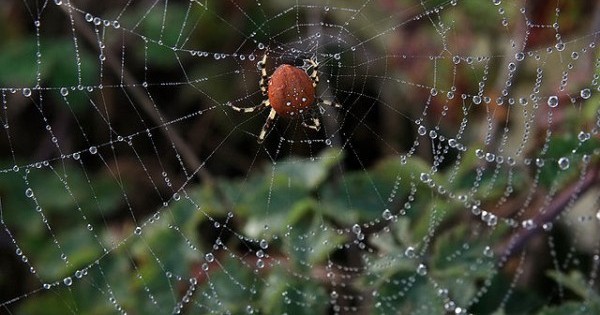
Anyone keeping house is keeping house spiders. What dwelling does not develop a cobweb upon occasion, and what is a cobweb but the spent tangleweb of the common house spider, Achaearanea tepidariorum? (Or it might be another “house spider,” Tegenaria domestica.) Here is a world busy within our world, but beneath our awareness except when we get out our spider exterminator, better known as a “vacuum cleaner.”
Spiders are not insects. They have two main body parts (insects have three) and no wings. The front part is the cephalothorax, and to it belong the eight eyes, the jaws, the eight legs. The back part is the abdomen. Along with insects and lobsters, spiders belong to the phylum Arthropoda, animals with an exoskeleton and jointed legs.
Our house spider belongs to the same family as the black widow (the Theridiidae family), but its venom (unlike the black widow’s) is not toxic to us. She lives about one year. She dines mainly on insects—flies, roaches, flour moths. She has spinnerets or spinners at her back end with which to spin her silk webs. These spinnerets are composed of tubes called spools and spigots that open to the outside and enable her to produce silk threads of various sizes. Spider silk is one of the strongest materials in existence. Alas, you can’t raise spiders for their silk due to their unfortunate tendency to eat their fellow spider.
Spiders reproduce sexually. The male is smaller and will hang out on the edge of Ms. Spider’s web. When he approaches to mate he will sometimes offer a fly for her to eat while he inserts his pedipalp into her epigyne. While sperm is being transferred, she may eat the fly or she may eat him instead.
Our house spider makes pear-shaped egg sacks, which are plainly visible in her web. Each contains about 600 eggs. When spiderlings hatch they feed on the unhatched eggs and then balloon away, airborne on their first thread of silk. They drop to somewhere and begin spinning a web of their own.
Thanks to the ancient Greeks and Romans, we know where spiders came from. Arachne was a girl, a weaver of cloth so stunning that she must have learned her craft, it was said (and is said in Allen Mandelbaum’s translation of The Metamorphoses of Ovid), from the goddess of domestic arts, Minerva. Arachne denied she’d received divine instruction, saying, in effect, if this goddess is so great, let her appear, let her compete. Minerva, beyond annoyed, did appear in the form of an old woman and begged Arachne to beg Minerva’s pardon. To this Arachne spat out, “Old age has addled you; your wits are gone,” etc., again challenging the goddess to come forward and compete. So Minerva took her own form, and the contest began. Both weavers wove transcendent tapestries, after which Minerva, in a jealous rage, began beating Arachne about the head. Arachne became hysterical and hanged herself. Minerva then took pity on the girl and, rather than let her perish, turned her into a spider. To this day Arachne (class, Arachnida) weaves beautiful webs in the corners of our rooms.
Or perhaps they are ugly webs, cobwebs, those abandoned tangle webs collecting dust and debris. While spinning out these words I have been getting up from time to time to peer into the ceiling corners of my study. Now, if you will excuse me—I have some vacuuming to do.

